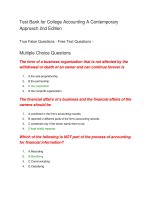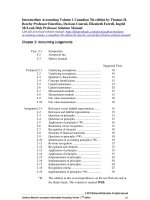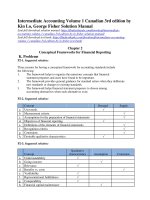TEST BANK COLLEGE ACCOUNTING CHAPTERS 1 27 22ND EDITION HEINTZ test b ch03 sol final
Bạn đang xem bản rút gọn của tài liệu. Xem và tải ngay bản đầy đủ của tài liệu tại đây (45.41 KB, 5 trang )
Chapter 3, TEST B
Name _________________________
Date _________________________
SCORING RECORD
Section
Total Possible
A
B
C
D
Total
30
30
10
30
100
Deductions
Student Score
Section A
Directions: Each of the following statements is true or false. Indicate your choice by writing in the Answers
column T for a true answer or F for a false answer. (2 points for each correct answer)
For
Answers
Scoring
A T account is used to keep track of the increases or decreases in the
individual assets, liabilities, owner’s equity, revenues, and expenses of a
business entity.
__T__
_____
2.
Debit means left and credit means right.
__T__
_____
3.
The difference between the debit side total and the credit side total of
an account is called the balance.
__T__
_____
Because assets are on the left side of the accounting equation, they are
decreased by a debit and increased by a credit.
__F__
_____
5.
Liability accounts normally have credit balances.
__T__
_____
6.
Every time one account is increased, another account must be decreased.
__F__
_____
7.
If Pauli received $500 in cash and $1,000 on account from customers for
services provided during the month, accounts receivable would be credited
for $1,500.
__F__
_____
Carlos withdrew $700 for personal use. This transaction decreases cash and
decreases owner’s equity.
__T__
_____
Wade paid his company’s $150 telephone bill for the month. The cash
should be credited and a prepaid asset account should be debited.
__F__
account
_____
10. Prepaid insurance is an asset account.
__T__
_____
11. When equipment is purchased, an expense account is debited for the
amount of the purchase.
__F__
_____
12. All of the debit balances from the trial balance are carried over to the
balance sheet.
__F__
_____
13. If the totals in both columns of a trial balance are equal, it proves that all of
the individual account balances are correct.
__F__
_____
__F__
equity.
_____
1.
4.
8.
9.
14. A trial balance is used to prove that assets plus liabilities equals owner’s
© 2017 Cengage Learning. All Rights Reserved. May not be scanned, copied or duplicated, or posted to a publicly accessible website, in whole or in part.
3-2
15. A trial balance is often used when preparing financial statements.
__T__
_____
© 2017 Cengage Learning. All Rights Reserved. May not be scanned, copied or duplicated, or posted to a publicly accessible website, in whole or in part.
3-3
Section B
Directions: Complete each of the following statements by writing in the Answers column the letter of the
word or words that correctly completes each statement or answers the question. (3 points each)
For
Answers
Scoring
A debit (A) decreases cash; (B) decreases revenues; (C) increases owner’s
equity; (D) decreases drawing; (E) increases liabilities.
__B__
_____
Net income appears in which financial statements? (A) Balance Sheet;
(B) Income Statement; (C) Statement of Owner’s Equity; (D) A & B;
(E) B & C.
__E__
_____
The normal balance is a credit in a(n) (A) asset account; (B) owner’s equity
account; (C) expense account; (D) drawing account; (E) none of these.
__B__
_____
Examples of expenses are (A) wages; (B) rents; (C) advertising; (D) utilities;
(E) all of these.
__E__
_____
The capital account (A) decreases with increased revenues; (B) decreases
with an investment; (C) decreases with increased expenses; (D) has a
normal debit balance; (E) always has a balance equal to the cash account.
__C__
_____
Ernst Elf pays his company’s bill for two years of insurance coverage. The
transaction (A) increases the drawing account and decreases an asset
account; (B) includes a debit to the cash account; (C) decreases an asset
account and a liability account; (D) increases expenses; (E) decreases one
asset account and increases another asset account.
__E__
_____
The trial balance should (A) only be completed if you think there is a
problem; (B) list all of the accounts for the business even if they do not
have a balance; (C) be submitted to the owner as a formal report for the
business; (D) always balance; (E) all of these.
__D__
_____
A purchase of equipment on account (A) decreases cash; (B) increases
an asset; (C) decreases owner’s equity; (D) decreases expenses;
(E) decreases revenue.
__B__
_____
The fact that each transaction has a dual effect on the accounting elements
provides the basis for what is called (A) single-entry accounting;
(B) compound-entry accounting; (C) multiple-entry accounting;
(D) double-entry accounting; (E) duplicate-entry accounting.
__D__
_____
10. Which of these always cause a decrease in owner’s equity? (A) an
increase in expenses and an increase in revenue; (B) a decrease in
expenses and a decrease in revenue; (C) a decrease in expenses and a
decrease in capital; (D) a decrease in expenses and an increase in revenue;
(E) none of these.
__E__
_____
1.
2.
3.
4.
5.
6.
7.
8.
9.
© 2017 Cengage Learning. All Rights Reserved. May not be scanned, copied or duplicated, or posted to a publicly accessible website, in whole or in part.
3-4
Section C
Directions: Indicate the normal balance (debit or credit) for each of the following accounts. (1 point each)
1.
Owner’s Drawing
_______Debit________
2.
Accounts Receivable
_______Debit________
3.
Accounts Payable
_______Credit_______
4.
Rent Expense
_______Debit________
5.
Supplies
_______Debit________
6.
Cash
_______Debit________
7.
Prepaid Insurance
_______Debit________
8.
Notes Payable
_______Credit_______
9.
Owner’s Capital
_______Credit_______
10. Equipment
_______Debit________
Section D
Fabio Fox has started his own taxi service. During the first month, the following transactions occurred.
(a) Fabio invested $120,000 cash in the business.
(b) Cellular phone equipment was purchased with cash for $1,800.
(c) Fabio purchased a taxi by paying $3,000 cash and $27,000 on account.
(d) Fabio paid a cell phone bill for the first month, $100.
(e) A $500 payment was made on account for the taxi.
(f) Fabio received $4,700 from customers.
(g) At the end of the month, Fabio owed Best Bookkeeping $450 for bookkeeping services received.
Directions: Record the above transactions in the T accounts provided on the next page. Foot and balance
the accounts. Prove debits equal credits. (30 points total)
© 2017 Cengage Learning. All Rights Reserved. May not be scanned, copied or duplicated, or posted to a publicly accessible website, in whole or in part.
3-5
Cash
Accounts Payable
(a) 120,000
27,000(a) 120,000
(f) 4,700 (c) 3,000
(d) 100
(e) 500
104,700
5,400
Bal119,300
F. Fox, Capital
(b) 1,800
(e) 500
(c)
(g)
450
Bal. 26,950
Cellular Phone Equip.
Phone Expense
(b) 1,800
Cell
(d) 100
Taxi
Service Fees
(c) 30,000
(f) 4,700
Bookkeeping Expense
(g) 450
Debits:
Cash
Cellular Phone Equipment
Taxi
Cell Phone Expense
Bookkeeping Expense
Total Debits
$119,300
1,800
30,000
100
450
$151,650
Credits:
F. Fox, Capital
Accounts Payable
Service Fees
$120,000
26,950
4,700
Total Credits
$151,650
© 2017 Cengage Learning. All Rights Reserved. May not be scanned, copied or duplicated, or posted to a publicly accessible website, in whole or in part.









